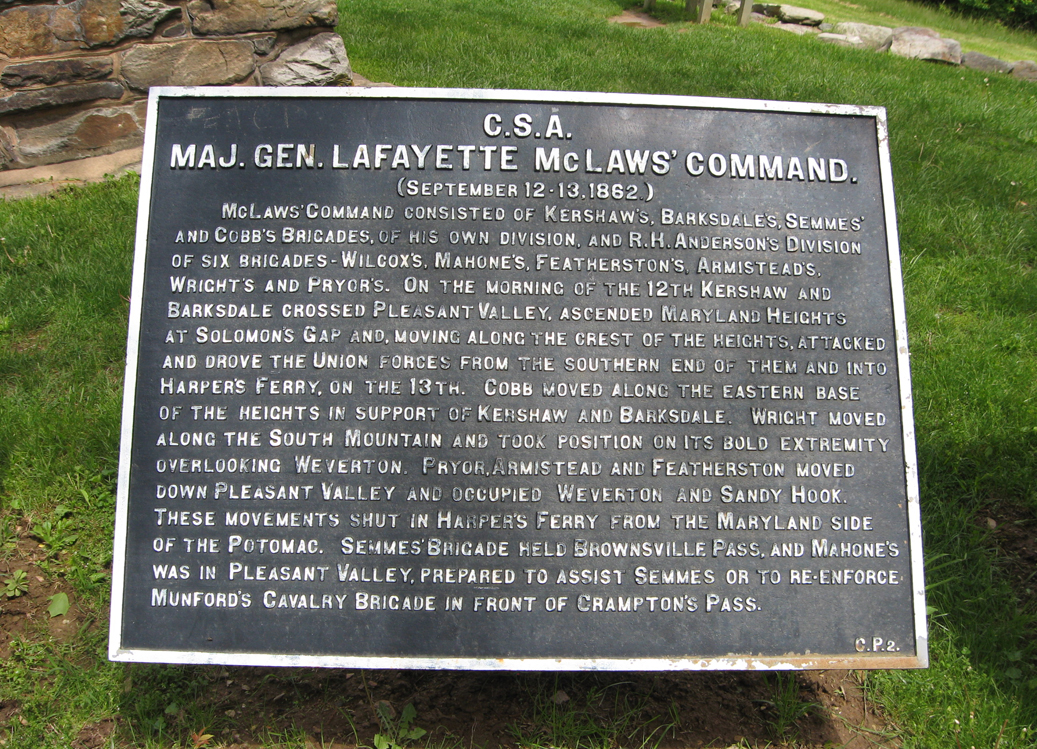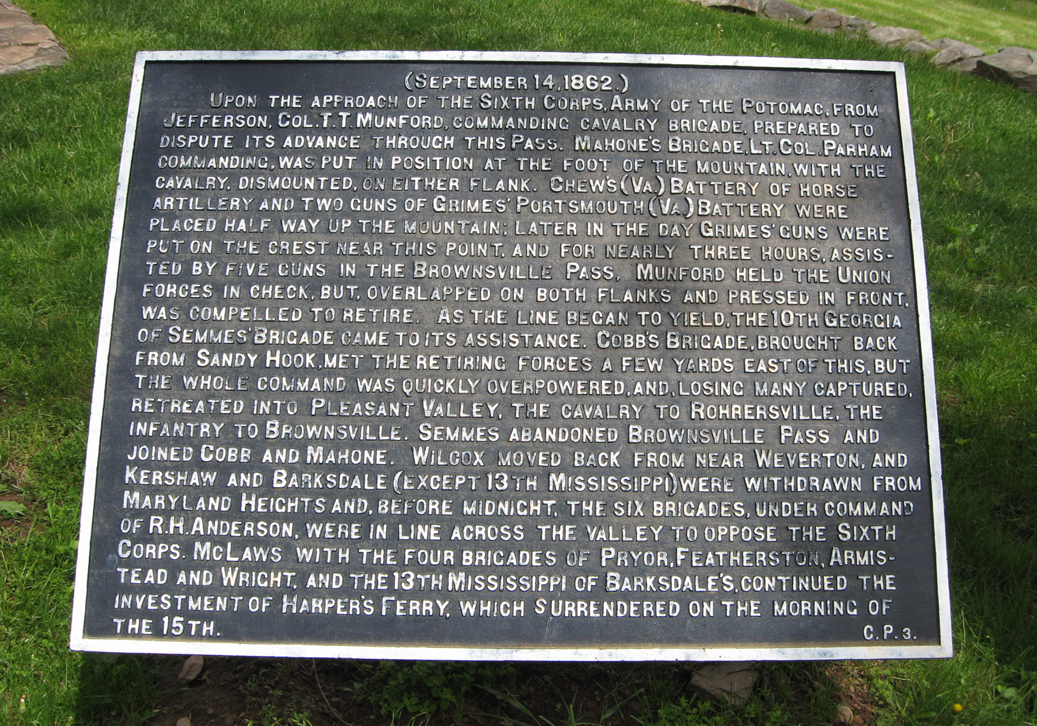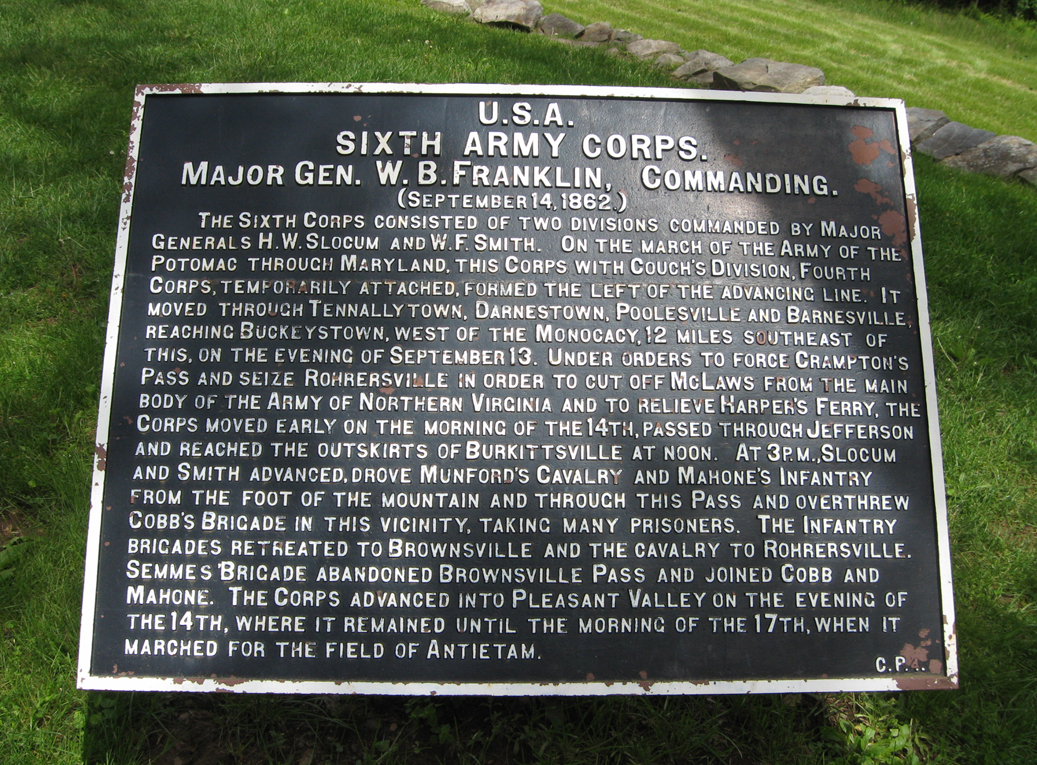Battle of South Mountain • Turner’s Gap • Fox’s Gap • Crampton’s Gap
In the 1890s the War Department set up iron markers on the Antietam battlefield and at other locations that were important to the battle such as Harpers Ferry and South Mountain. Five markers tell the story of Crampton’s Pass, or Crampton’s Gap. Four of the markers are next to the War Correspondents Memorial Arch on the north side of Crampton’s Gap Road and the fifth is in Burkittsville at the intersection of Gapland Rpad and Mountain Church Road.
There is another set of War Department markers at Turner’s Gap.

From the first marker:
Between September 4th and 7th, 1862, the Army of Northern Virginia, General Robert E. Lee, Commanding, crossed the Potomac near Leesburg, and occupied Frederick, Maryland. On the 10th a movement was made to surround and capture the Union forces at Harpers Ferry. Early that morning General T. J. Jackson with Jackson’s (Stonewall) Division and the Divisions of R. S. Ewell and A. P. Hill left Frederick, marched over South Mountain at Turner’s Pass, six miles north of this, crossed the Potomac near Williamsport on the 11th, seized Martinsburg on the 12th and marching by way of Charlestown on the 13th invested Harpers Ferry from the Virginia side of the Potomac. General Lee with the Division of D. R. Jones and J. B. Hood and the Brigade of N. G. Evans, marched to Hagerstown. D. H. Hill’s Division halted at Boonsboro to prevent the escape of the garrison at Harpers Ferry through Pleasant Valley and to support Stuart’s Cavalry which remained east of South Mountain to observe the movements of the Union Army and retard its advance. McLaws with his own Division and that of R. H. Anderson moved from Frederick on the 10th, in rear of D. H. Hill, left the Frederick and Hagerstown Pike at Middletown, crossed South Mountain at Brownsville Pass, one mile south of this and bivouacked near Brownsville on the night of the 11th. On the 12th McLaws marched onto Maryland Heights and down Pleasant Valley to invest Harpers Ferry from the Maryland side of the Potomac, leaving Semmes’ Brigade to hold Brownsville Pass. Mahone’s at Brownsville and Munford’s Cavalry in front of Crampton’s Pass to guard his rear and observe the movements of the Union Army.

From the second marker:
Maj. Gen. Lafayette McLaws’ Command
(September 12-13, 1862)
McLaws’ Command consisted of Kershaw’s, Barksdale’s, Semmes’ and Cobb’s Brigades of his own division and R. H. Anderson’s Division of six brigades – Wilcox’s, Mahone’s, Featherston’s, Armistead’s, Wright’s and Pryor’s. On the morning of the 12th, Kershaw and Barksdale crossed Pleasant Valley, ascended Maryland Heights at Solomon’s Gap and moving along the crest of the heights, attacked and drove the Union forces from the southern end of them and into Harpers Ferry. On the 13th Cobb moved along the eastern base of the heights in support of Kershaw and Barksdale. Wright moved along the South Mountain and took position on its bold extremity overlooking Weaverton. Pryor, Armistead and Featherstone moved down Pleasant Valley and occupied Weaverton and Sandy Hook. These movements shut in Harpers Ferry from the Maryland side of the Potomac. Semmes’ Brigade held Brownsville Pass, and Mahone’s was in Pleasant Valley, prepared to assist Semmes or to re-enforce Munford’s Cavalry Brigade in front of Crampton’s Pass.

From the third marker:
Upon the approach of the Sixth Corps, Army of the Potomac, from Jefferson, Col. T. T. Munford, commanding Cavalry Brigade, prepared to dispute its advance through this pass. Mahone’s Brigade, Lt. Col. Parham, commanding, was put in position at the foot of the mountain, with the cavalry, dismounted, on either flank. Chew’s (Va.) Battery of Horse Artillery and two guns of Grimes’ Portsmouth (Va.) Battery were placed half way up the mountain; later in the day Grimes’ guns were put on the crest near this point, and for nearly three hours, assisted by five guns in the Brownsville Pass, Munford held the Union forces in check, but, overlapped on both flanks and pressed in front, was compelled to retire. As the line began to yield, the 10th Georgia of Semmes’ Brigade came to its assistance. Cobb’s Brigade brought back from Sandy Hook, met the retiring forces a few yards east of this, but the whole command was quickly overpowered, and losing many captured, retreated into Pleasant Valley, the cavalry to Rohrersville, the infantry to Brownsville. Semmes abandoned Brownsville Pass and joined Cobb and Mahone. Wilcox moved back from near Weverton, and Kershaw and Barksdale (except 13th Mississippi) were withdrawn from Maryland Heights and, before midnight, the six Brigades, under command of R. H. Anderson, were in line across the valley to oppose the Sixth Corps. McLaws with the four brigades of Pryor, Featherstone, Armistead and Wright, and the 13th Mississippi of Barksdale’s continued the investment of Harpers Ferry, which surrendered on the morning of the 15th.

From the fourth marker:
Sixth Army Corps.
Major Gen. W. B. Franklin, Commanding
(September 14, 1862)
The Sixth Corps consisted of two divisions commanded by Major Generals H. W. Slocum and W. F. Smith. On the march of the Army of the Potomac through Maryland, this Corps with Couch’s Division, Fourth Corps, temporarily attached, formed the left of the advancing line. It moved through Tennallytown, Darnestown, Poolesville and Barnesville, reaching Buckeystown, west of the Monocacy, 12 miles southwest of this, on the evening of September 13. Under orders to force Crampton’s Pass and seize Rohrersville in order to cut off McLaws from the main body of the Army of Northern Virginia and to relieve Harpers Ferry, the Corps moved early on the morning of the 14th, passed through Jefferson and reached the outskirts of Burkittsville at noon. At 3 p.m., Slocum and Smith advanced, drove Munford’s cavalry and Mahone’s infantry from the foot of the mountain and through this pass and overthrew Cobb’s Brigade in the vicinity, taking many prisoners. The infantry brigades retreated to Brownsville and the cavalry to Rohrersville. Semmes’ Brigade abandoned Brownsville Pass and joined Cobb and Mahone. The Corps advanced into Pleasant Valley on the evening of the 14th where it remained until the morning of the 17th when it marched for the field of Antietam.
From the fifth marker in Burkittsville:
Col. T. T. Munford, 2nd Virginia Cavalry, Commanding,
Munford’s Brigade,
2nd & 12th Virginia Cavalry.
Mahone’s Brigade,
Lt. Col. Wm. A. Parham, 41st Virginia, Commanding.
6th, 12th, 16th, 41st, and 61st Virginia Infantry
(September 14, 1862)
